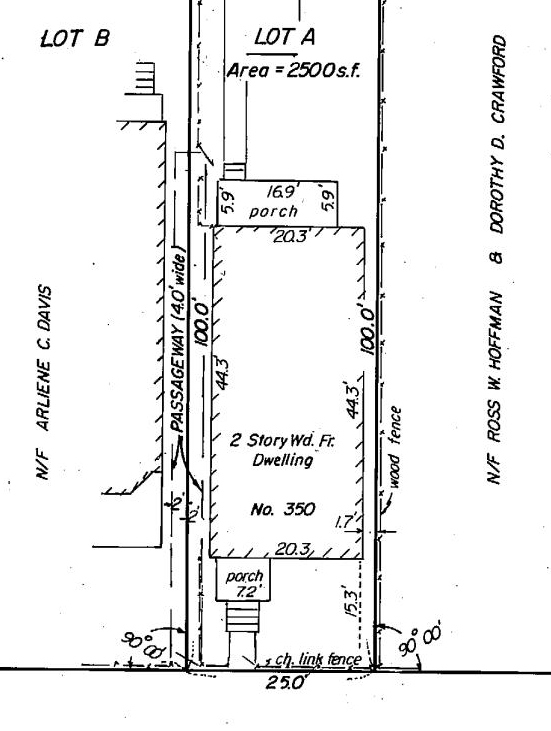Easement
ease·ment/ˈēzmənt/
noun: easement; plural noun: easements
- 1.LAW a right to cross or otherwise use someone else’s land for a specified purpose.
Wait….WHAT?! Why would I give someone a right to cross my land!? Well, you might. Or, they might give you a right to cross theirs.
Does this really happen? It sounds crazy? There are lots of things in real estate that I find surprising, even after many, many years.
Easements aren’t *that* unusual. Sometimes they are 100+ years old, sometimes they are created even today. The idea behind an easement (often) is that a benefit is bestowed on someone that is much greater than the actual easement that is drawn on paper.
A common type of easement is for parking. I owned a property once in Arlington that had an easement along one side of my lot. The easement was given to the neighbor so that their property could have a driveway.
Their *easement* allowed them park there, put a driveway there, required them to maintain the driveway, and lasted forever with the land.
Why? Without this easement, they would not have had a place to park. Perhaps this easement was given out of good will. Perhaps it was given because the town required every house to have parking. Perhaps money or favors exchanged hands to set up this easement.
The result, though, is that the neighbor could park there and I could not use the land.
And what about my property? I *owned* that land and I paid taxes on it, but why would I not just sell that parcel to that person and be done with it?
There can be benefits to retaining the ownership, even once the easement is in place. One is about zoning. When you own a property of a certain size…the area of the lot and the “frontage” that the lot has on the streets….zoning determines, based on the square footage of the lot and the frontage, among other things, what you can build on your lot. Zoning determines where on your lot you can build, how many square feet your structure can be, and how tall it can be. By retaining ownership of the easement portion of the land, it is possible that you could have beneficial rights that allow you to build more, build taller, and build closer to that driveway than you could if you did not own it. Even if there is an easement.
In modern times, sometimes these easements are required to allow a structure, or a particular type of structure to be built. Perhaps my property in Arlington could have become a three unit structure instead of a two unit structure because I had that little extra bit of lot. That situation makes that strip of easement extremely valuable for me to maintain.
For clients encountering an easement during a purchase, this often feels immediately invasive. What are we giving these people? What people? Who will maintain this? Who controls how it is used? Can I put a fence up? Can they? Is this….forEVER?
For these answers, I hand it over to an attorney. The easement is recorded in the deed for the property. Some of them date back to the days of handwritten deeds and the specifics and language might not seem as easy to interpret as something written today.
Here is the language of the easement written to the benefit of my neighbor from my land:
“…with a full right of way over a strip of land six feet contiguous to said premises on the Northwesterly side thereof from Sawin Street to the Westerly side of line of said Lot #79…”
Um, yeah….that isn’t exactly crystal clear. But that is why we have attorneys to help us. And over time, they can be subject to disputes and revisions.
Here is one that I saw on a property this week, the current deed said:
“…Subject to restrictions and easements of record and more particularly an easement created for the benefit of the adjoining parcel at 115 Allston St. recorded at Book 5569 Page 161…”
So the current deed just says….”hey, this property has an easement, I just wanted you to know”. Then it says…”If you want to know more about it, do look it up here…”
That’s where the torrent of words comes in. There are many, many words about the owners and the properties, in general, then it gets to the details of the easement:
“…NOT THEREFORE, the said parties do hereby establish and dedicate a common eight (8) foot driveway between their said estates, four (4) feet of which shall be on each of said lots, said right of way extending back from the street line a distance of ninety-six feet, said way to be forever kept open and unobstructed for all the usual purposes of a private driveway, the maintenance, repair and grade of said way to be the common responsibility of the respective owners now or future, of said estates, and each of said parties hereto, does hereby grant to the other and his respective heirs, successors, legal representatives and assigns, said right of way as so established, and each agrees that their lots of land above described shall hereafter be subject to the easement of said common driveway for the benefit of the future owners and occupants of said lots….”
Here is an example of plan that contains a similar easement.

Wow. So what happens when a client is looking to purchase a property with an easement? We ask the attorneys. What does this mean? Where is this located on the property? What can the do with it? What can we do with it? Who is responsible for it? What are the risks and benefits going forward?
Is it that weird or shocking? Not usually. Will changes be made to an easement as part of your purchase? Not usually, unless the reason that it was created doesn’t exist any longer. Then maybe.
Should you worry about an easement. Always ask an attorney.
